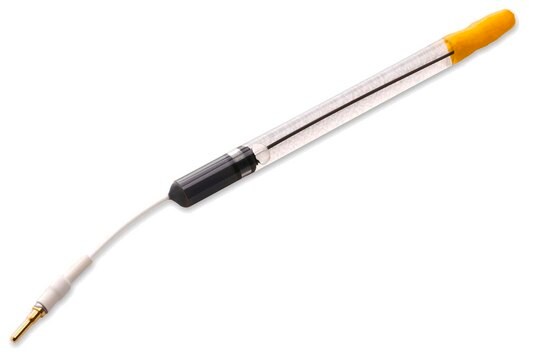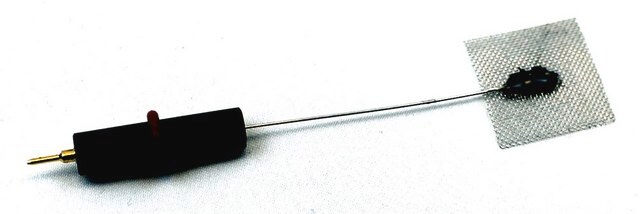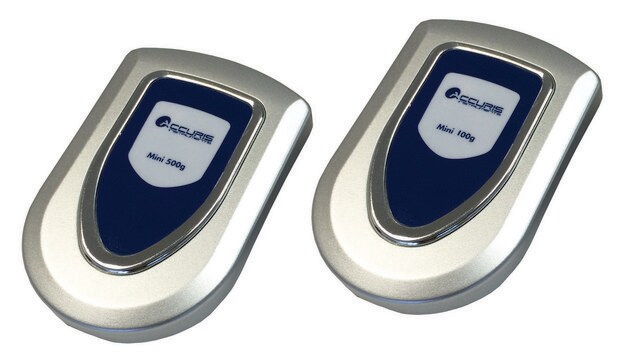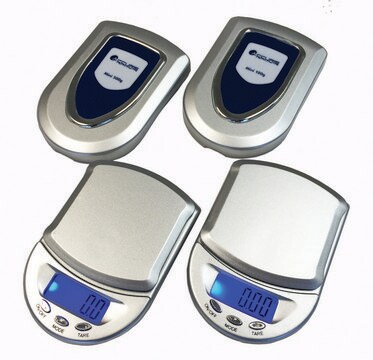Z744270
Wilmad® Suprasil® Electrolytic Assembley
for use with Joel, pack of 1
Sinonimo/i:
EPR kinetic study assembly, electrolytic cell assembly
Autenticatiper visualizzare i prezzi riservati alla tua organizzazione & contrattuali
About This Item
Codice UNSPSC:
41115600
NACRES:
NB.15
Prodotti consigliati
Confezionamento
pack of 1
Produttore/marchio commerciale
Wilmad WG-810-J-Q
Compatibilità
for use with Joel
Cerchi prodotti simili? Visita Guida al confronto tra prodotti
Descrizione generale
Electrochemistry is employed in many EPR kinetic studies to generate free radicals and avoids alkali metal reductions, the associated sample sensitivity to air or moisture and background signal. A complete cell includes two Calomel Reference Electrodes, a pair of Platinum Electrodes, and a gas bubbler for deoxygenation. The Electrolytic Cell Assembly comes as a complete unit with CFQ or Suprasil® Flat Cell. The Flat Electrolytic Cells have two Standard Taper 10/30 outer joints at the top, one for the Gas Bubbler and a Platinum Electrode and at the botom a single Standard Taper 5/20 outer joint for the other Platinum Electrode, the remainder of the Flat Cell is CFQ. A minimum 15mL of sample solution needs to make contact with the electrodes and gas bubbler. The cell width for
JEOL spectrometers is 10mm outside (WG-810-J-Q), for other spectrometers, the cell width is 10.5mm outside (WG-810-Q). The Gas Bubbler Assembly is a three-piece Pyrex® chamber which holds part of your sample it has three Standard Taper 10/30 outer joints at the top for the Gas Bubbler and two Calomel Electrodes. The lower Standard Taper 10/30 inner joint fits into the top of the Flat Electrolytic Cell. Nitrogen should be bubbled through the solution before and during the experiment to remove paramagnetic oxygen and mix the sample during electrolysis. The Platinum Electrodes are prepared using 0.016? (0.4mm) diameter wire. The upper electrode, WG-810-C, uses 8? (203mm) of platinum and acts as the working electrode in oxidation reactions. The lower electrode, WG-810-D, has only 2? (50mm) of platinum and acts as the auxiliary electrode in oxidation reactions. If you add a few drops of mercury to the cell, the lower electrode can be used as the working cathode in reduction reactions. Each Platinum Electrode incorporates a Pt-to-W weld. The tungsten (W) external wire lets you quickly clip your potentiostat leads to the electrode.Electrolysis Limits in Water (vs. Saturated Calomel Electrode)
JEOL spectrometers is 10mm outside (WG-810-J-Q), for other spectrometers, the cell width is 10.5mm outside (WG-810-Q). The Gas Bubbler Assembly is a three-piece Pyrex® chamber which holds part of your sample it has three Standard Taper 10/30 outer joints at the top for the Gas Bubbler and two Calomel Electrodes. The lower Standard Taper 10/30 inner joint fits into the top of the Flat Electrolytic Cell. Nitrogen should be bubbled through the solution before and during the experiment to remove paramagnetic oxygen and mix the sample during electrolysis. The Platinum Electrodes are prepared using 0.016? (0.4mm) diameter wire. The upper electrode, WG-810-C, uses 8? (203mm) of platinum and acts as the working electrode in oxidation reactions. The lower electrode, WG-810-D, has only 2? (50mm) of platinum and acts as the auxiliary electrode in oxidation reactions. If you add a few drops of mercury to the cell, the lower electrode can be used as the working cathode in reduction reactions. Each Platinum Electrode incorporates a Pt-to-W weld. The tungsten (W) external wire lets you quickly clip your potentiostat leads to the electrode.Electrolysis Limits in Water (vs. Saturated Calomel Electrode)
Applicazioni
EPR
Caratteristiche e vantaggi
- Complete cell includes two Calomel Reference Electrodes, a pair of Platinum Electrodes, and a gas bubbler
- Electrolytic Cell Assembly comes as a complete unit with CFQ or Suprasil® Flat Cell
Note legali
PYREX is a registered trademark of Corning, Inc.
Suprasil is a registered trademark of HERAEUS QUARZGLAS GMBH & CO.
Wilmad is a registered trademark of SP Industries
Certificati d'analisi (COA)
Cerca il Certificati d'analisi (COA) digitando il numero di lotto/batch corrispondente. I numeri di lotto o di batch sono stampati sull'etichetta dei prodotti dopo la parola ‘Lotto’ o ‘Batch’.
Possiedi già questo prodotto?
I documenti relativi ai prodotti acquistati recentemente sono disponibili nell’Archivio dei documenti.
Il team dei nostri ricercatori vanta grande esperienza in tutte le aree della ricerca quali Life Science, scienza dei materiali, sintesi chimica, cromatografia, discipline analitiche, ecc..
Contatta l'Assistenza Tecnica.








